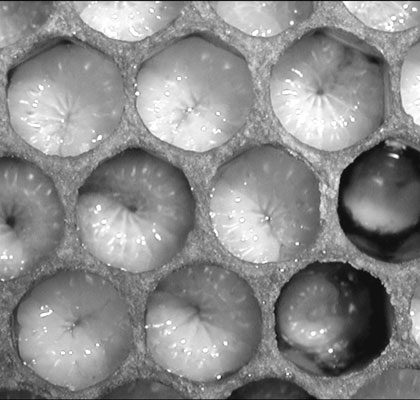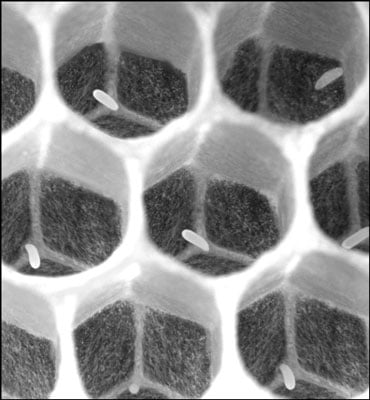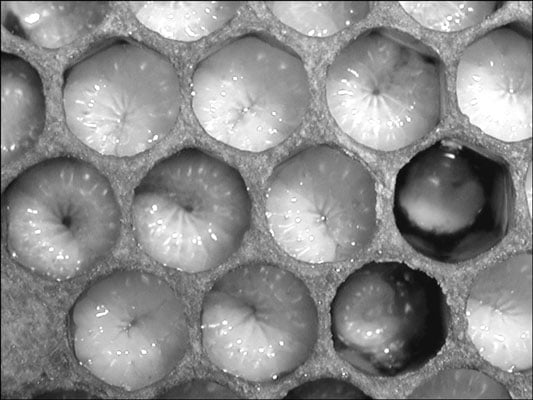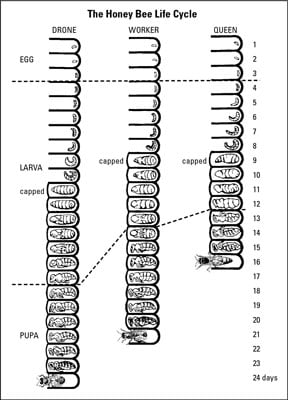The Life Cycle of a Honey Bee

The Life Cycle of a Honey Bee. Honey bees develop in four life cycles, egg, larva, pupa, and adult. The total development time varies among the three bees, queen, worker or drone but the basic process is the same. 24 days for drones, 21 days for worker bees, and 16 days for queens.
The Life Cycle of a Honey Bee begins when the queen lays an egg. You should know how to spot eggs, it is one of the most basic and important skills you’ll need as a beekeeper. It isn’t an easy task, because the eggs are small, about the size and shape of a grain of rice. Finding eggs is one of the best ways to confirm that your queen is alive and well. It’s a skill you’ll use just about every time you visit your hive.
The queen lays a single egg in each cell that has been cleaned and prepared by the workers to raise new brood. The cell must be spotless, or she moves on to another cell.

Notice the rice shape of the eggs and how the queen has positioned them standing up in the cell. If the eggs are not positioned this way or multiple eggs show up in a single cell, it can indicate a potential issue.
If the queen chooses a standard size cell, she releases a fertilized egg into the cell. That egg develops into a worker female bee. If she chooses a wider drone cell, the queen lays a non fertilized egg. That egg develops into a drone male bee. The worker bees that build the cells are the ones that regulate the ratio of female worker bees to male drone bees. They do this by building smaller cells for female worker bees, and larger cells for male drone bees.
If you are using foundation in your hives, we prefer to use black. The black foundation creates contrast from the white colored egg and makes them much easier to see.
Three days after the queen lays an egg, it becomes a larvae. Larvae are white and look like grub worms curled up in the cells. The larvae grow quickly and shed their skin five times.
The nurse bees feed the larvae royal jelly at first, then a mixture of pollen and honey. Within five days, they are 1,500x larger. Then the worker bees seal the larvae in the cell with a capping of brown beeswax. Once they are sealed in the cell, the larvae spin a cocoon around their bodies.

The larva is now a pupa. This is the stage that it begins to look like a bee but the changes now taking place are hidden from sight under the wax capping. The eyes, wings and legs take shape. Coloration begins with the eyes first pink, then purple, then black. Finally, the hairs that cover the bee’s body develop. 12 days later, the adult chews her way through the wax capping to join the hive
.

Cell cleaning: days 1 and 2
When a worker or female bee is first emerges from her cell, her first job is to clean so the cell can be used again by the queen to raise another bee. If the cell is not spotless the queen will not use it and the bee will have to continue to clean until it is satisfactory to be used by the queen.
Nurse bee: days 3 to 11
Nurse bees have the job of feeding the brood. They must feed and take care of brood to ensure they develop into another worker for the beehive. At first they feed royal jelly and then they feed a mixture of pollen and honey until the cell is capped.
Wax production: day
Cell cleaning (days 1–2)
Brood cells must be cleaned before the next use. Cells will be inspected by the queen and if unsatisfactory they will not be used. Worker bees in the cleaning phase will perform this cleaning. If the cells are not clean, the worker bee must do it again and again.
Nurse bee (days 3–11)
Nurse bees feed the worker larvae worker jelly which is secreted from glands that produce royal jelly. They will also go into the special cells to create a semi-royal jelly that is similar to the royal but it tastes more like honey.
- Advanced Nurse Bees (days 6–11)
- Nurse Bees will then feed royal jelly to the queen larva and drones receive worker jelly for 1 to 3 days at which time they are started on a diet of honey.
Wax production (days 12–17)
Wax bees build cells from wax, repair old cells, and store nectar and pollen brought in by other workers. Early in the worker’s career she will exude wax from the space between several of her abdominal segments. Four sets of wax glands, situated inside the last four ventral segments of the abdomen, produce wax for comb construction.
Foraging Bees: Days 17-42
For the remainder of the worker bees life they become foragers. They leave the beehive and fly up to 2 miles in one direction to collect pollen, nectar and propolis to be used by the hive.
Check out some of our great products at https://petricbees.com/sale for the many options on how you can get started in beekeeping.
